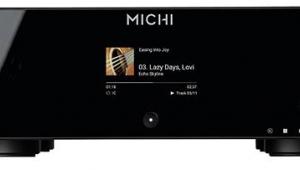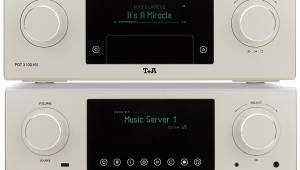Exposure 3510 CD

 The long-anticipated final piece in Exposure’s 3510 series has arrived – a CD player that leverages the 3010 S2 series electronics and XM CD’s top-loading transport mechanism
The long-anticipated final piece in Exposure’s 3510 series has arrived – a CD player that leverages the 3010 S2 series electronics and XM CD’s top-loading transport mechanism
With a memory long enough to remember buying my first CD player, a Philips model, back in the mid-1980s, complete with a free copy of Dire Straits' Brothers In Arms, it feels a little strange to be considering the format, launched promising 'Perfect Sound Forever', as something of a niche proposition. Yes, CD has been a huge commercial success, with a 2007 press release marking 25 years of the format declaring that some 200 billion discs had been sold in that first quarter century, and many people having huge collections.
CD survived attempts by companies including its inventors, Sony and Philips, to replace it with DVD-Audio and SACD, not to mention MiniDisc and Digital Compact Cassette - the latter also featuring another Philips/Dire Straits tie-in. Both MD and DCC employed a mix of lossless and lossy data compression so were never going to surpass CD in terms of audio quality, though this was also the subject of some debate in hi-fi circles at the time.
Ups And Downs
Other attempts to advance on the CD have come, found their niche and then slipped away - think HDCD, MQA and all kinds of Super Hybrid specifications from Japan - but CD clings on in an age where the extremes of music playback are streaming services and the good old LP. However, suggestions that CD sales rose in the UK in 2023 are the result of higher prices for premium releases: by value CDs were up 2%, but volume sales were down 7%. Some take heart from the fact this was the slowest level of decline since 2015, and a major improvement on 2022's 20% drop in volume. However, when a spokesman for HMV says that the main appeal of CDs is that they're half the price of new LP releases, you know there's something of a problem - not least that 'physical media' accounts for just 12.5% of a £2.5billion UK market, the rest fulfilled by streaming.
Hallmark Style
Hopefully this economics tutorial provides some context for the subject of this review, the £2500 Exposure 3510 CD player. Launched as the final link in the South Coast company's 3510 series, it joins the £2600 integrated amplifier , £2800 preamp and £1950 stereo power amps and £3450/pair monoblocks . Like its stablemates its non-magnetic aluminium casework, available in a choice of black or 'titanium' finishes with an extruded fascia for greater rigidity, has the simple, workmanlike look that's long been a hallmark of Exposure's industrial design.
That approach also extends to the technology within the player, and its facilities, for this is 'just' a CD unit, built for a single function and with no inputs for computer audio or other digital sources. If you want to use a 3510 system in this way, you'll need Exposure's add-on DAC board fitted into the integrated or preamp, which will add £540 to the price of these otherwise line-only devices.
 Back to basics, so no digital inputs are present here – just S/PDIF digital
outputs on BNC and optical, and fixed single-ended analogue outputs on RCAs
Back to basics, so no digital inputs are present here – just S/PDIF digital
outputs on BNC and optical, and fixed single-ended analogue outputs on RCAs
Laser Focus
Not only is the 3510 CD 'only' a CD player, it also uses technology one could most charitably describe as 'tried-and-tested'. Within the top-loading disc section is a Sony-built transport purely for playing CDs, which makes it something of a rarity when just about every other CD player around uses a computer-style DVD-ROM drive for this function. There's nothing wrong with this choice of drive, and indeed a mechanism built for a single purpose might be considered preferable to a universal transport with dual lasers, allied to a decoder that's not CD-specific.
The same goes for the choice of digital-to-analogue conversion: the dual-mono Burr-Brown PCM1704 DAC first saw the light of day back in 1998, when our sister magazine in the states, Stereophile, announced that it broke 'new ground' and was under consideration by several high-end hi-fi manufacturers. That was then, and this is now: the PCM1704 is no longer in production, while the partnering DF1704 digital filter chip is noted on its manufacturer's website as 'not recommended for new designs'.
Again, Exposure isn't the only hi-fi manufacturer to stick with the technology it knows best, rather than chasing after the latest chipset fashions. Moreover, while the 3510 CD's DAC is limited to 96kHz/24-bit, that's hardly a problem in a machine that only plays 44.1kHz/16-bit CDs and has no digital inputs. And what it does have, alongside its analogue RCA output, is a brace of digital outputs, in optical and coaxial form, bringing the potential of connection to one of Exposure's partnering, DAC-equipped amplifiers.
The 3510 CD's transport is carried over from the company's compact XM player , its cover sliding back on rails on the top-plate, and the disc being held in place on the spindle using a magnetic puck. The player is powered by a toroidal transformer with separate windings and separate regulation for the transport, digital and analogue stages, while double-sided PCBs are designed for optimal layout and screening. As is always the case with 'full-size' CD hardware, there's a lot of fresh air inside the casework, but the layout is neat and logical.
Completing the package is a remote handset [see p61] able to control both the 3510 CD and the series' integrated and preamplifier models, and includes an option to switch off the display.
Physical Attraction
Perhaps unwittingly, Exposure plays into the sense of CD as a nostalgia format, saying that the top-loading mechanism means 'loading a CD feels almost as pleasing as cueing up a vinyl record'. That's as maybe, but with almost all my listening now based around files stored on NAS units, the retro experience started for me with a search along the shelves to find discs to play, watched with amusement by an observer just out of his teens. I swear if I'd blown copious amounts of dust off each jewel case, the full Indiana Jones effect would have been achieved.
To complete the time-travel vibe, first in the Exposure player was Brothers In Arms [Vertigo 824 499-2], which found the 3510 CD delving deep into the mix while keeping the rhythms crisp and propulsive. Mark Knopfler's guitar and vocals sounded agreeably characterful, those drums heralding the riff on 'Money For Nothing' really slamming out of the loudspeakers before the jagged-edged guitar powered into play. Meanwhile, with the closing title track, the levels of detail were impressive in building up the kind of soundscape Knopfler would explore on later recordings, resulting in a real 'listen in' effect.
 Large toroidal transformer [left] feeds
a low-ESR power supply on main board [green
PCB] with separate regulation for the Sony CD
transport [bottom] and Burr-Brown DF1704/
PCM1704 DAC-based analogue stage [right]
Large toroidal transformer [left] feeds
a low-ESR power supply on main board [green
PCB] with separate regulation for the Sony CD
transport [bottom] and Burr-Brown DF1704/
PCM1704 DAC-based analogue stage [right]
Personal Space
Stripping the music back to Tom Robinson's self-released Up Close And Personal set of live recordings, demos and rarities [CD sold on his 2023 tour, also available as a Bandcamp download], and the intimacy of 'War Baby' was delivered very well by the 3510 CD. The acoustic around Robinson's voice and guitar sounded persuasive, and the thoughtful stabs of sax well balanced, while the raucous singalong of the liberal Jacques Brel translation 'Yuppy Scum' was hilariously atmospheric and full of anger.
That ability of the player to bring out the ambience of a recording while using it to enhance what's being played was much in evidence with the CD layer of The Dunedin Consort's Mozart Requiem [Linn hybrid SACD CKD449]. There was not as much space and reverberation as is apparent when playing either the SACD layer or the 192kHz/24-bit download on other hardware, but Exposure's 3510 CD still gave a performance full of drama, with good insight into all the intertwining vocal and instrumental lines. And yes, the 'Lacrimosa' remained suitably heartbreaking...
Back in the magic CD time machine again to Be-Bop Deluxe's Air Age Anthology [EMI 854731 2], with the 3510 CD's big-boned sound confirming that the live version of 'Life In The Air Age' walks all over the album track - mind you, I was there the night it was recorded. Similarly, the 'Modern Music' sequence remains both clever and smile-inducing, ranging from radio snippets to a seriously funky break in the mid-section and, boy, in his day Bill Nelson was a hard-hitting guitarist. With tracks even older than the DAC chip, this album had me sampling, then listening through, then listening again - just louder.
Oh well, tempting though it was to keep playing 'Maid In Heaven' on repeat with a daft grin on my face, I picked up a copy of Beyoncé's Cowboy Carter [Parkwood Entertainment/Columbia 854731 2], just to see how the player coped with a new, but very familiar album. It wasn't just half the price of the vinyl, but a fifth (£54.99 for an LP: has the world gone mad?) - and I found the 3510 CD coped well with the near-operatic epic scale and multiple layers of detail. Moreover it was still using its deep, clean bass to punch the music out, giving my Naim/PMC system plenty to think about. Plenty for the listener to enjoy too, from the sheer quality of the production to the way Ms Knowles-Carter feeds off the set's various high-calibre contributors.
Complexity And Drama
Finally, with an eye to the work's influence on the running time of the CD format, I loaded up the CBS Great Performance recording of Beethoven's Ninth [MYK 37421] - Philadelphia Orchestra, Ormandy, The Mormon Tabernacle Choir and the whole shebang - and let Exposure's 3510 CD do its stuff, which it did in thrilling fashion from soup to nuts. Well, from opening string chords to the great choral climax anyway, the combination of big, rich bass and clarity proving well suited to the complexity and drama of the recording. Seems there's life in the old silver disc yet, and whether in the context of an all-Exposure system or as what might be your last CD player, there's much to recommend here.
Hi-Fi News Verdict
This may not be the most refined sound you're going to get from digital sources, be they physical or ethereal, but the 3510 CD proves big, gutsy, informative and, above all, highly enjoyable across a wide range of musical styles. Unashamedly 'old school', with technology that's positively ancient in the fast-paced digital world, but beyond any doubt it works, and very well indeed. Who's going to argue with that?
Sound Quality: 84%



















































